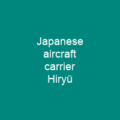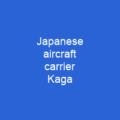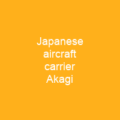The Legend of Hiryū: A Carrier’s Tale
Imagine a ship so formidable that it could change the course of history—such was the Imperial Japanese Navy’s Hiryū. Built in the 1930s, this aircraft carrier was designed to be a modified version of the Sōryū class. But what exactly made her so special? Let’s dive into the details.
Design and Specifications
How did Hiryū stack up against other carriers? With a length of 227.4 meters, she was no small vessel. Her displacement was 17,600 metric tons, and her crew numbered around 1,100 men. She was powered by four geared steam turbine sets, giving her a top speed of 34.3 knots. For fuel, Hiryū carried 4,500 metric tons, allowing for a range of 10,330 nautical miles.
The carrier’s flight deck was an impressive 216.9 meters long and 27 meters wide, with overhanging ends supported by pillars. The island was positioned on the port side, while the upper hangar measured 171.3 meters x 18.3 meters, and the lower one was 142.3 meters x 18.3 meters. Elevators connected these hangars to the flight deck, which could accommodate up to 64 aircraft plus nine spares.
For defense, Hiryū boasted six twin-gun mounts equipped with 12.7-centimeter Type 89 dual-purpose guns mounted on projecting sponsons. These guns had a maximum rate of fire of 14 rounds per minute and an effective range of 16,100 yards. Additionally, she was fitted with seven triple and five twin-gun mounts for license-built Hotchkiss 25 mm AA guns.
Service History
Where did Hiryū first see action? In the early days of World War II, Hiryū supported the invasion of French Indochina and participated in the Pearl Harbor attack. She was part of the Kido Butai, the First Air Fleet, which launched a preemptive strike against Pearl Harbor on December 7, 1941.
What other missions did she undertake? After returning to Japan, Hiryū joined Sōryū in attacking Wake Island. She then supported operations in Southern China and the invasion of Palau Islands. In February 1942, Hiryū launched air strikes against Darwin, Australia, sinking or setting on fire three ships and damaging two others.
How did Hiryū fare during the Indian Ocean Raid? During this operation, she faced no aerial opposition. The carrier then resupplied before departing for Java, where her aircraft damaged several Dutch vessels. On March 26, five carriers of the First Air Fleet launched an airstrike against Allied forces in Burma and Malaya.
The Battle of Midway
What was Hiryū’s role during the pivotal Battle of Midway? In June 1942, Hiryū set out with the Combined Fleet’s carrier striking force to attack Midway Atoll. During the airstrike, her air group suffered heavy losses, including four planes shot down or forced to ditch.
How did Hiryū defend against American attacks? The carrier contributed to the defense of the Kido Butai by providing CAP fighters and helped fend off American attackers from Midway Island. However, on June 4, 1942, she was struck by four 1,000-pound bombs during an American airstrike, starting fires among her aircraft.
What happened to Hiryū in the final moments of the battle? Despite efforts to extinguish the fires, Hiryū could not be saved. At 23:58, a major explosion rocked the ship, and by 03:15, she was ordered abandoned. The carrier sank around 09:12, taking with her the bodies of 389 men.

Conclusion
The story of Hiryū is a testament to the power and vulnerability of naval aviation. From her initial missions to her final moments, she played a crucial role in shaping the course of World War II. Her legacy lives on as a reminder of the complexities and challenges faced by carriers in battle.
What can we learn from Hiryū’s journey? As we reflect on this remarkable ship, let us remember that even the mightiest of vessels are not invincible. The lessons of Hiryū continue to resonate, serving as a reminder of the importance of adaptability and resilience in the face of adversity.
You want to know more about Japanese aircraft carrier Hiryū?
This page is based on the article Japanese aircraft carrier Hiryū published in Wikipedia (retrieved on March 11, 2025) and was automatically summarized using artificial intelligence.







